I bid farewell to the Philippines after an incredible month there. According to my previous plan, after Indonesia and the Philippines, I would travel to Vietnam. Things changed though and after speaking to some travellers I met in Indonesia and to some of my friends back home, I decided to travel to Myanmar. The reason? Myanmar is one of the few countries in Southeast Asia that is still “pure”, meaning, it is not as touristic as others. And, just like that, after a 6-hour flight from Manila, I arrived to the former capital of Myanmar. I didn’t know it just yet but I would end up spending 2 days in Yangon 🙂
Day 1 in Yangon
I arrived at Yangon International Airport at around 08:30 on November the 21st, 2018. The flight took around 6 hours. I thought both countries were kind of nearby but I was wrong! I guess there were other people feeling the same way because, as we were waiting for our luggage, they starting stretching like if they had been on the plane for days.
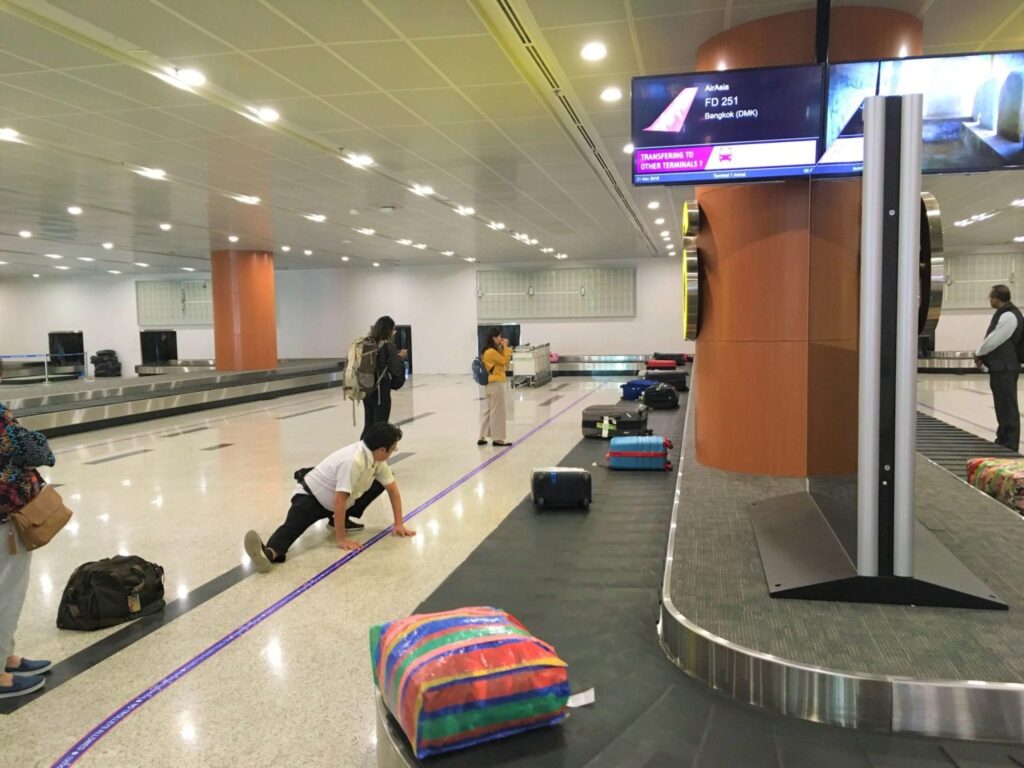
From Yangon International Airport to Yangon City Center
After getting my backpack I looked around until I found an ATM. It had a maximum amount of money you could withdraw so I just withdrew the maximum (around 400 K). Back then, I didn’t get the impression Grab was widely used. I did some quick research and, apparently, public transport wasn’t the best option. Either you had to walk for quite a while to the bus stop, the bus station was far away from the city center or another “inconvenient”. Thus, I decided to use the bargain skills I had gained during my time in Indonesia and the Philippines and I ended up getting a taxi.
After negotiating with different taxi drivers I got a deal with one who agreed to take me to my hostel for 10 K. Some others wanted to take me for 15 K so I guess it was a good enough deal. The thing is, since they don’t have taximeters, if you don’t negotiate, you might end up paying way more than you should.
The taxi driver was kind and talkative and, during the ride, we spoke about different things. I wasn’t sure what topics were “allowed” and what weren’t but, in the end, we spoke about pretty much everything. We spoke about the previous dictatorship, the new democracy, football (the most important sport in the country), religion (Myanmar is home to thousands of Buddhist temples) and other stuff. Thanks to him I also found out that, in Yangon, scooters are not allowed, but just cars. The same goes for coins, they just use banknotes. Up till that moment I had never been in such a city 🙂
Where to stay in Yangon?
Initially I booked just one night at Backpacker Hostel but then I ended up spending one more. I paid around 5 Euros per night with (a delicious) breakfast included. So, the stories people told me about the expensive accommodation in Myanmar seemed not to be truth, at least, as of now. The room was a male shared one but, on the website, it didn’t even say how many beds there were. Weird, huh?
I would find out next day that there were a lot of beds. Some were “above” the others but they were not the typical bunk beds. There were “real” stairs connecting the ground to the upper bed and each bed was covered with curtains. The corridor was long, spacious and clean and, overall, I was really happy with my choice. It turned out that they were all taken and so, they upgraded (for free) me to a 3-person room (whose price was 30 $). It had been years since I had last slept on such a bed 🤩
Wandering around Yangon
Unfortunately the room was not ready yet and so I decided to go for a walk around the quarter. There were some stuff I needed to arrange and I felt it was the right time to do it.
Buying a SIM card in Myanmar
Back at the airport I got the chance to buy a SIM card but I didn’t do it. MPT was supposed to be the one with the best coverage and, since it wasn’t available at the airport, I decided to wait until I was in the city. During my previous trips prices from the airport to the city changed quite a lot, but it wasn’t the case in Myanmar, at least as far as SIM cards go.
I found a mobile phone shop, walked in and, after around 10-15 minutes trying to speak English, doing signs with my hands and writing on a piece of paper, I managed to buy a MPT SIM card with 8 GB and 1K in phone calls for 10 K. The language barrier was there but I did my best to overcome it 😉
Burmese readings
With the SIM card already in my phone, I kept wandering around. I saw plenty of people on the street, but no tourists whatsoever. As I walked I ran into plenty of food street stalls. The food looked nice and, I would find later on it also tasted pretty good. Well, to be honest, I didn’t try the one you have below, but I found it “interesting” lol.
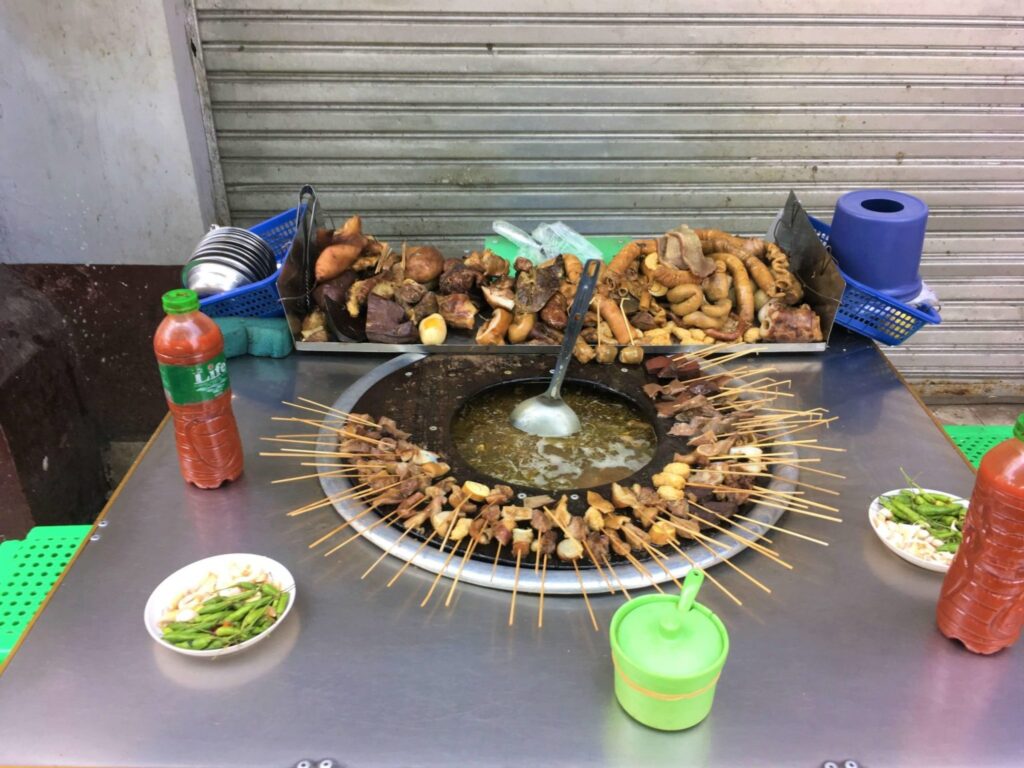
There were also plenty of book stalls all around. I guess you know George Orwell? The one who wrote (among many others) 1984. Well, I didn’t know it but, it turns out that he had spent five years in Myanmar. His time there triggered hatred towards the British Imperialism, which would be channelled into his novel “Burmese Days”.
There were a lot of interesting books, many with George Orwell as the main actor. I decided to buy “Finding George Orwell in Burma” by Emma Larkin, because I felt it would be interesting to read it while travelling around the country. The book was interesting but the reading felt kind of too thick and, unfortunately, it became the second book I haven’t finished in my life.
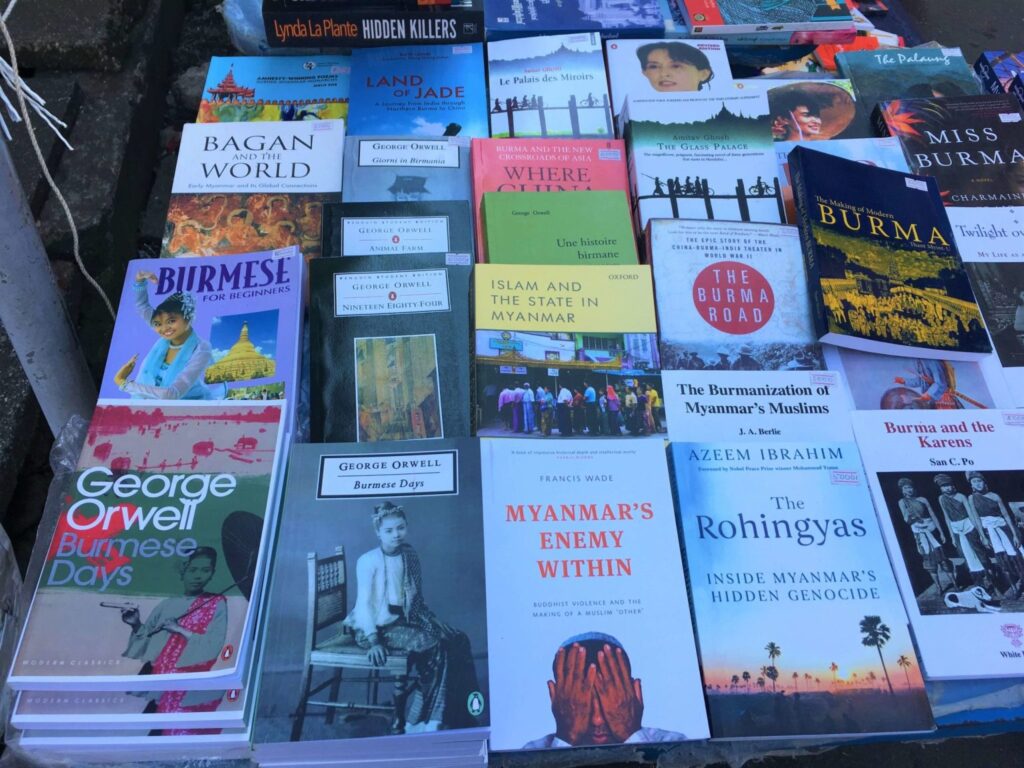
Maha Bandula Park
Eventually, my feet took me to a nice-looking park, where I strolled around for a while. Maha Bandula Park is surrounded by important buildings such as Yangon City Hall, Sule Pagoda and Yangon High Court. The park was founded in 1868 as Fytche Square in honour to the Chief Commissioner of British Burma, Albert Fytche. A white marble statue of Queen Victoria was placed in the center of the park in 1896, gifted by a wealthy Armenian firm in Yangon.
After 1948, the Independence Monument, an obelisk in commemoration of Burmese independence from the British, was installed at the centre of the park, replacing the statue of Queen Victoria. The statue of Queen Victoria was brought back to England after Myanmar Independence. The architect of this Independence Monument, Sithu U Tin, is the same architect who built Yangon City Hall.
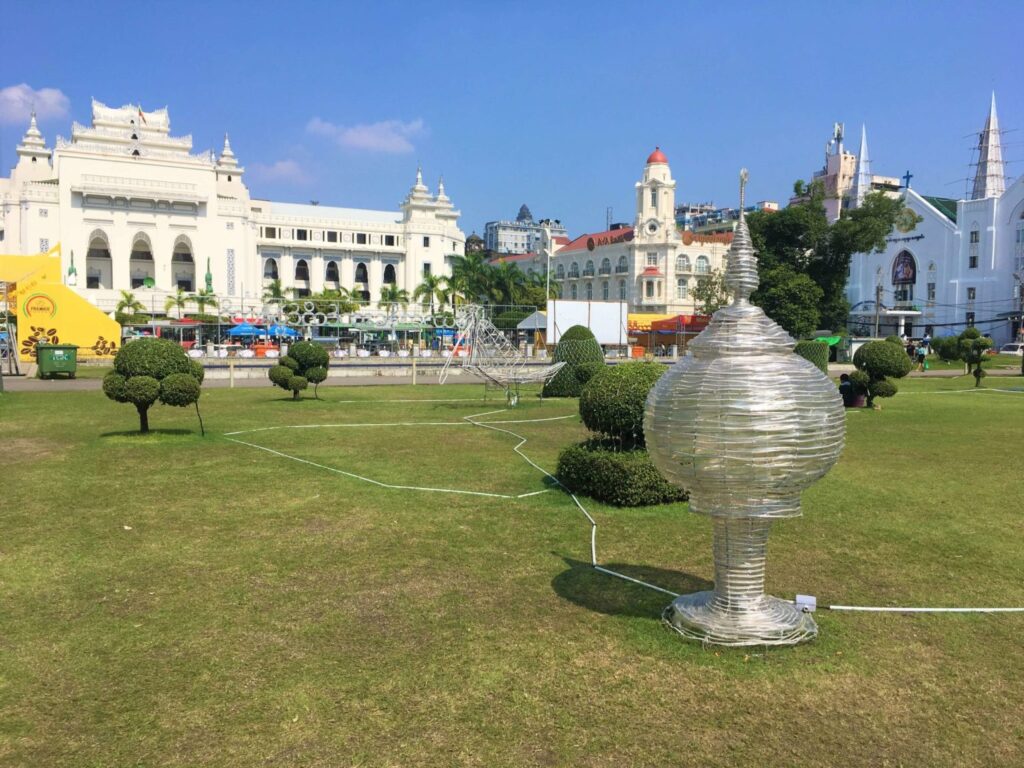
I spoke to some locals who were selling Thai coffee (weird, isn’t?) and found out that night and the next one they would be hosting a full moon celebration in the park and in other areas of the city. They told me they would also be having a light festival and my heart started beating harder. I thought they would be throwing lanterns to the sky, like in Thailand. But then I would find out it wasn’t the case 🙁
Sule Pagoda
In front of the park there was a beautiful golden-looking pagoda. I felt like it was calling me and I walked to the entrance. I had to pay an entrance fee and I wasn’t sure whether it would be worth it or not. Sometimes, during my 3-month solo trip, I got the impression that in some places they charged me just because I was a tourist. And I felt like that right then. I was dealing with my thoughts when I saw two girls coming out of the pagoda and I asked them whether it was worth it.
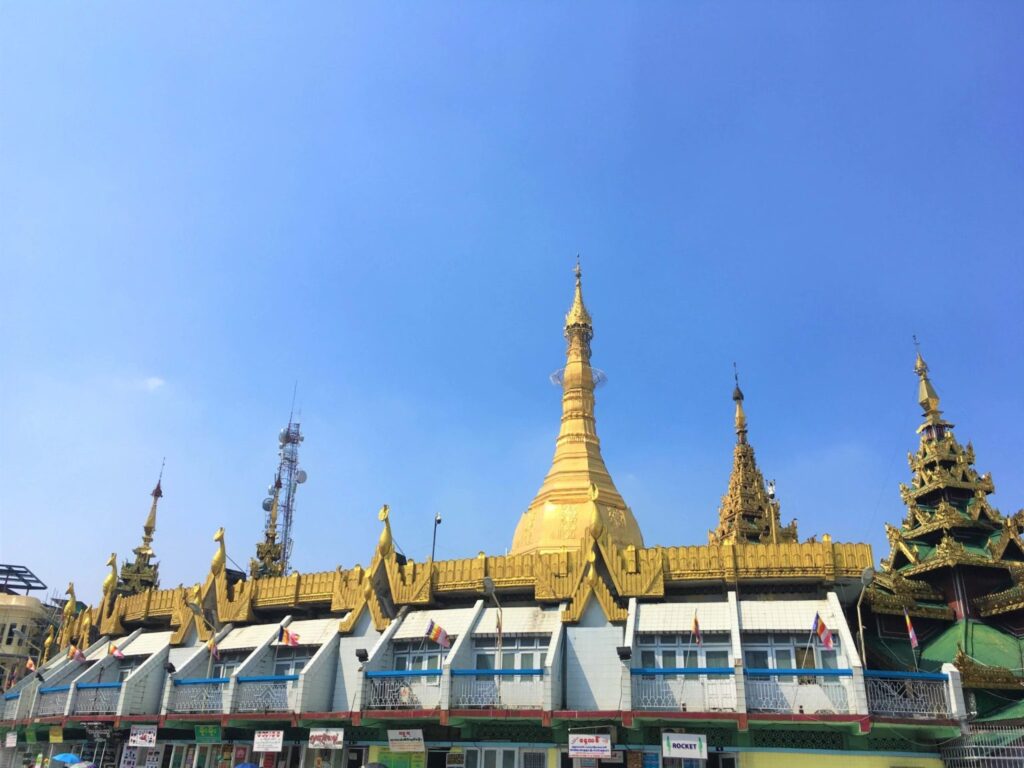
It turned out they were French and we spoke for a while. They had also just arrived in Yangon and they were doing some sightseeing. We exchanged Facebook contacts and we agreed upon meeting later on. After talking to them I decided to enter to Sule Pagoda and check it out. It wasn’t expensive but it was never about the price, but about whether someone had to pay just because of being a tourist.
About Sule Pagoda
According to the legend, it was built before the Shwedagon Pagoda, during the time of the Buddha, making it more than 2600 years old. The Sule Pagoda incorporated the original Indian structure of the stupa, which initially was used to replicate the form and function of a relic mound. However, as Burmese culture became more independent of its South Indian influences, local architectural forms began to change the shape of the pagoda. It is believed to enshrine a strand of Buddha’s hair that the Buddha himself gave to the two Burmese merchant brothers, Trapusa and Bahalika.
The Sule Pagoda is located in the center of downtown Yangon and is part of the city’s economic and public life. During the 1988 and 2007 protests, the Sule Pagoda was a functional meeting point for anti-government and pro-democracy protesters. Sadly, in both 1988 and 2007, the Sule Pagoda became the first place to witness the brutal reaction by the Burmese government against the protesters.
Visiting Sule Pagoda
The stupas and the whole area within Sule Pagoda were pretty nice. There were some locals praying and walking around. I strolled around for a while, enjoying the views. Then I felt like meditating for a while in such a unique place, and, eventually, left. The good thing about Myanmar is that, being a Buddhist country, is not weird to see people meditating. So you can do it pretty much anywhere and they won’t think you are crazy lol.

After my visit to Sule Pagoda I walked back to Backpacker Hostel. I was pretty tired so, after stopping at a random bar and having some delicious food, I laid down on the nice mattress and slept for a while.
Shwedagon Pagoda
I felt much better after the nap, ready to keep making the most out of my 2 days in Yangon. After taking a shower and checking Clara and Lea hadn’t texted me, I decided to go visit Shwedagon Pagoda on my own. It took me an hour to walk there but I felt like walking and I enjoyed it. I saw plenty of street food stalls and people walking around. There was an exotic smell coming from the food as well as weird orange stains on the ground. I would find later on what was the reason behind the stains.
On the way there I also saw plenty of cars but no scooters, as my taxi driver had told me. The buildings were not very tall. Some of them looked kind of deteriorated but others were colorful and beautiful. People were on the street fixing cars, eating, arranging some stuff, etc. It gave me the feeling I was in Andalusia somehow, at least as far as the neighbourhood life goes. I even ran into the Myanmar Times and something that looked like a cathedral!
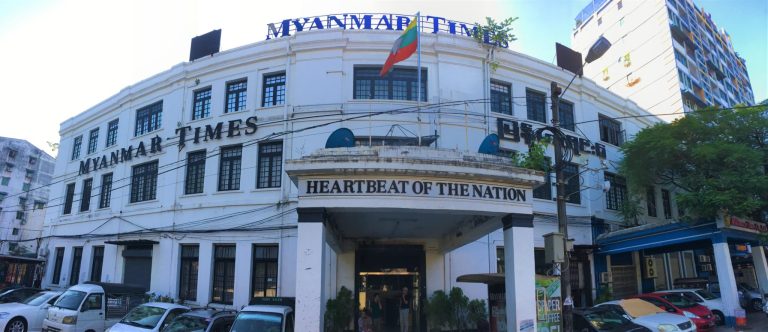
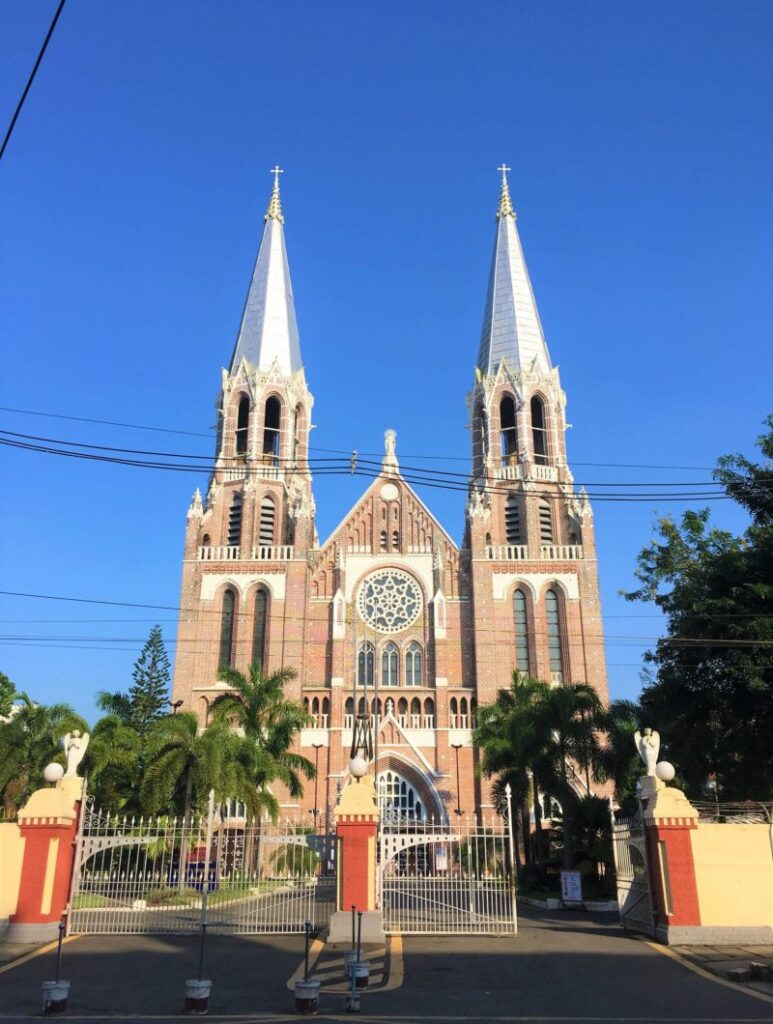
I had been walking for around 40 minutes when I started to see the imposing main stupa from Shwedagon Pagoda. It is the one of the tallest in the country, with a height of 100 meters, so I guess it was kind of expected 🙂
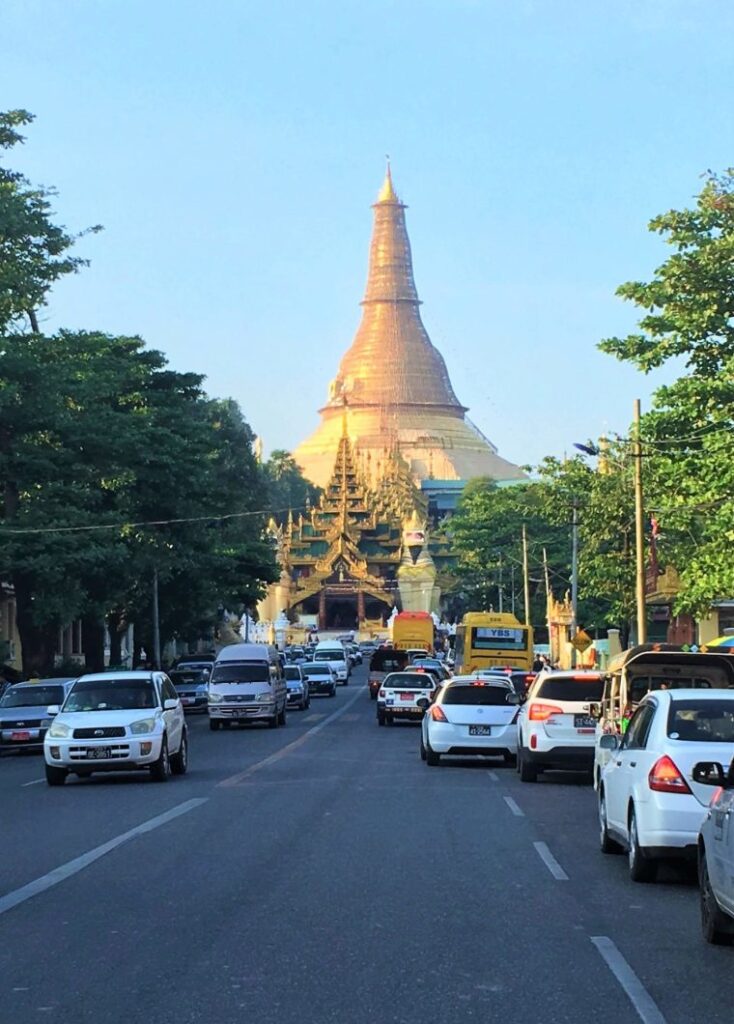
About Shwedagon Pagoda
Shwedagon Pagoda, also known as the Great Dagon Pagoda and the Golden Pagoda, is a gilded stupa located on Singuttara Hill, to the west of Kandawgyi Lake. Shwedagon Pagoda is the most sacred Buddhist pagoda in Myanmar, as it is believed to contain relics of the four previous Buddhas of the present kalpa. These relics include the staff of Kakusandha, the water filter of Koṇāgamana, a piece of the robe of Kassapa, and eight strands of hair from the head of Gautama.
Like Sule Pagoda, according to the legend, the pagoda was built more than 2600 years ago. It seems it was also the brothers Trapusa and Bahalika who, after meeting Gautama Buddha and thanks to the help of the local ruler King Okkalapa, triggered the construction of the Shwedagon Pagoda. Like many important buildings around the world, Shwedagon Pagoda was subject to many changes, due to different rulers’ preferences and earthquakes.
The main stupa is covered with gold plates, diamonds and rubies. There are four entrances, each followed by stairs to the platform on Singuttara Hill. Each entrance is flanked by a pair of leogryphs. The eastern and southern entrances are full of people selling books, luck charms, candles, gold leafs, incense sticks and many other stuff. According to the Buddhist religion, one must go around the Stupa following a clockwise direction. Just so you know 😉
Visiting Shwedagon Pagoda
I paid 10 K for the entrance fee, including the lending of some sort of sarong to cover my shoulders and knees. Not sure what entrance I used, but I saw locals preparing their food which later would eat inside the Pagoda as well as plenty of stalls selling different souvenirs. Once at the platform, I was completely astonished by the views. The main stupa was pretty impressive and beautiful. The golden glitter made it even more magical. Unfortunately, the top of the stupa was undergoing some restoration, but it was still pretty nice, as you can see here:
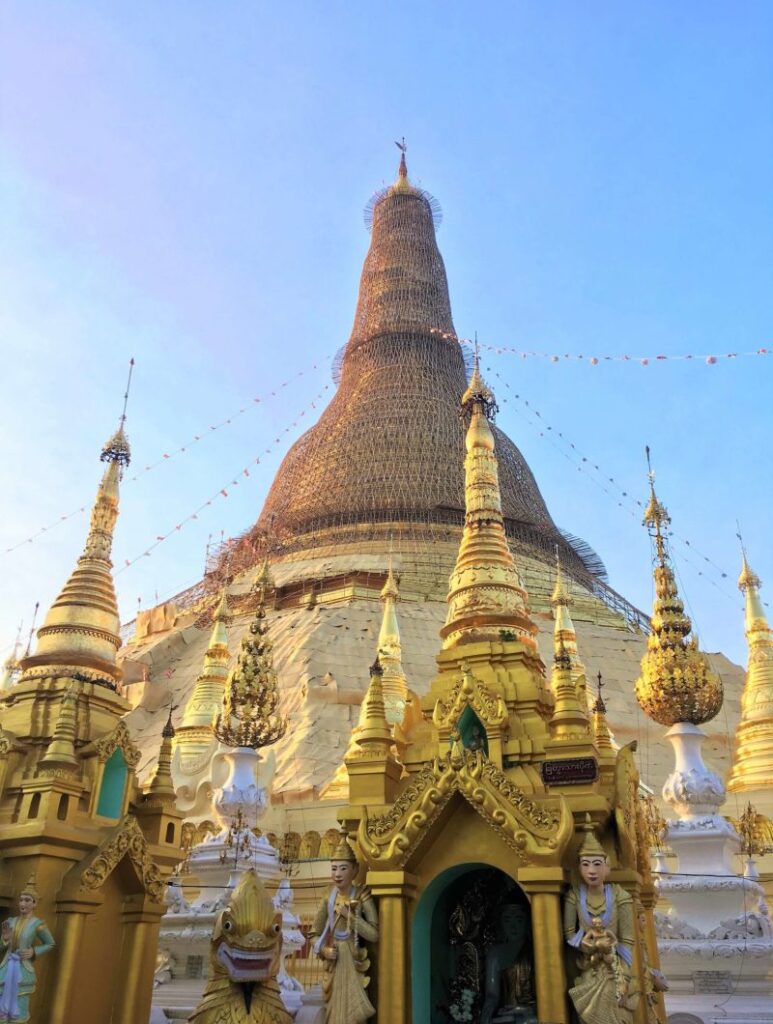
There were plenty of locals but I didn’t see many tourists. Some of them were praying, others were just walking around (not sure how many of them were walking in a clockwise direction) and others were chilling and eating. After a while walking around, I decided to sit down and take a break. It was then that I saw Clara and Lea. What a coincidence!
We kept checking the whole Shwedagon Pagoda area together. There were plenty of Buddha statues, small shrines and pagodas. Unfortunately, there were many things we didn’t understand, due to the language or the religion itself. It might have been nice to hire the services of a tour guide. So, if you are visiting Shwedagon Pagoda and want to know as much as possible from it, you might hire one.
We had heard that watching the sunset from Shwedagon Pagoda was pretty nice, but we didn’t find the right spot. Nonetheless, as the night fell, the Pagoda was as beautiful or even more than during the day time. It looked like this:
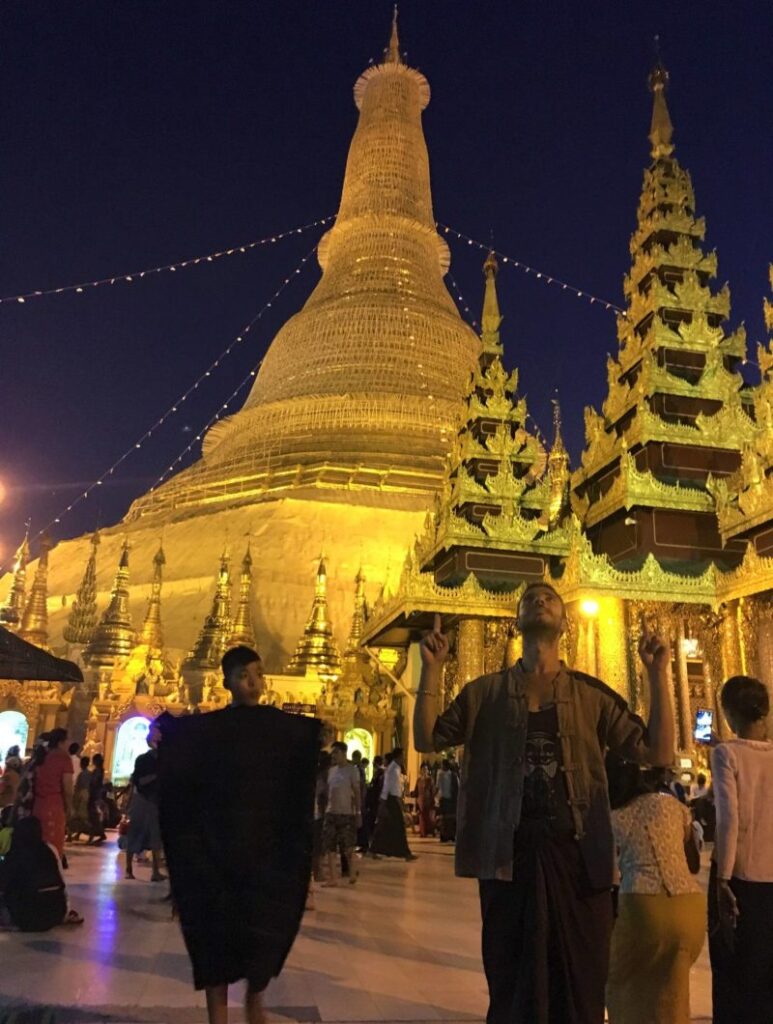
People’s Square and Park
We left Shwedagon Pagoda behind and had some “tapas” on the street. There were plenty of food stalls and we tried some deep-fried stuff. It is a typical dish from Myanmar and you had different choices from samosas to spring rolls to buttered vegetables. The food was good and cheap and, as we were eating, our feet took us to People’s Park.
We were kind of lost at some point but we were lucky enough to run into some people who spoke English. They advised us to go check People’s Square, where, apparently, a full moon party was taking place. They were not using lanterns (unfortunately) but the light show, along with the fountain and the views of Shwedagon Pagoda was pretty nice. It reminded me to the Font Magica in Montjuic.
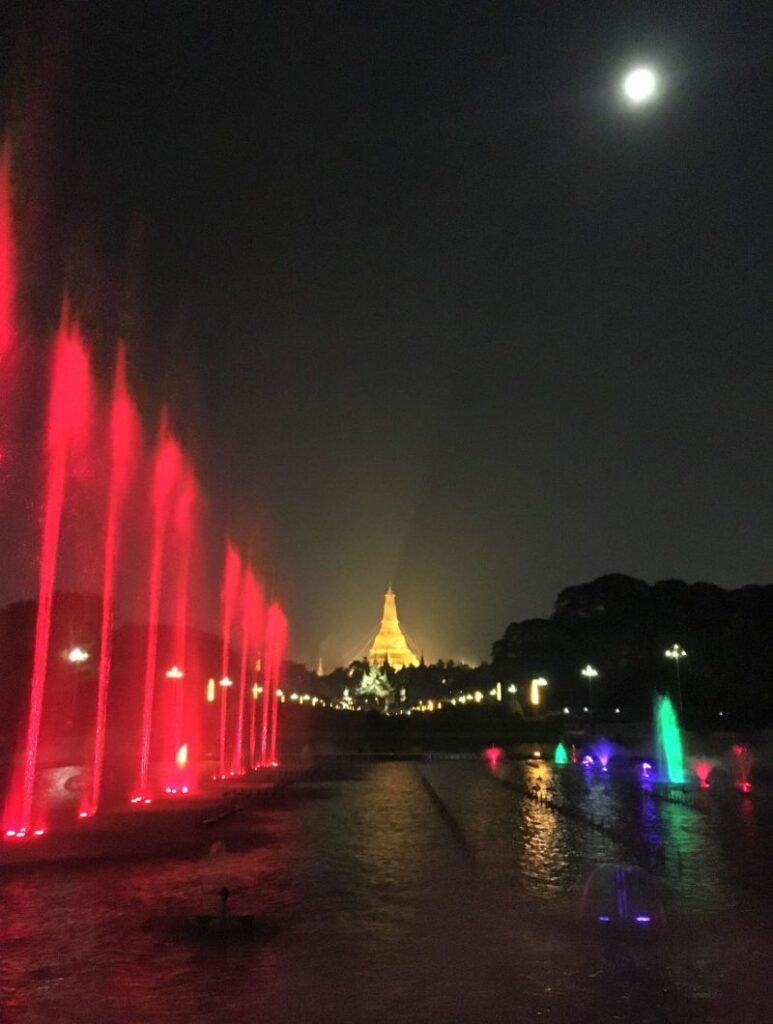
We sat down and enjoyed the show and the views. Some locals approached us and started dancing and asked us to join them. After a while, they asked us if they could take a picture with us. We agreed without hesitation 🙂
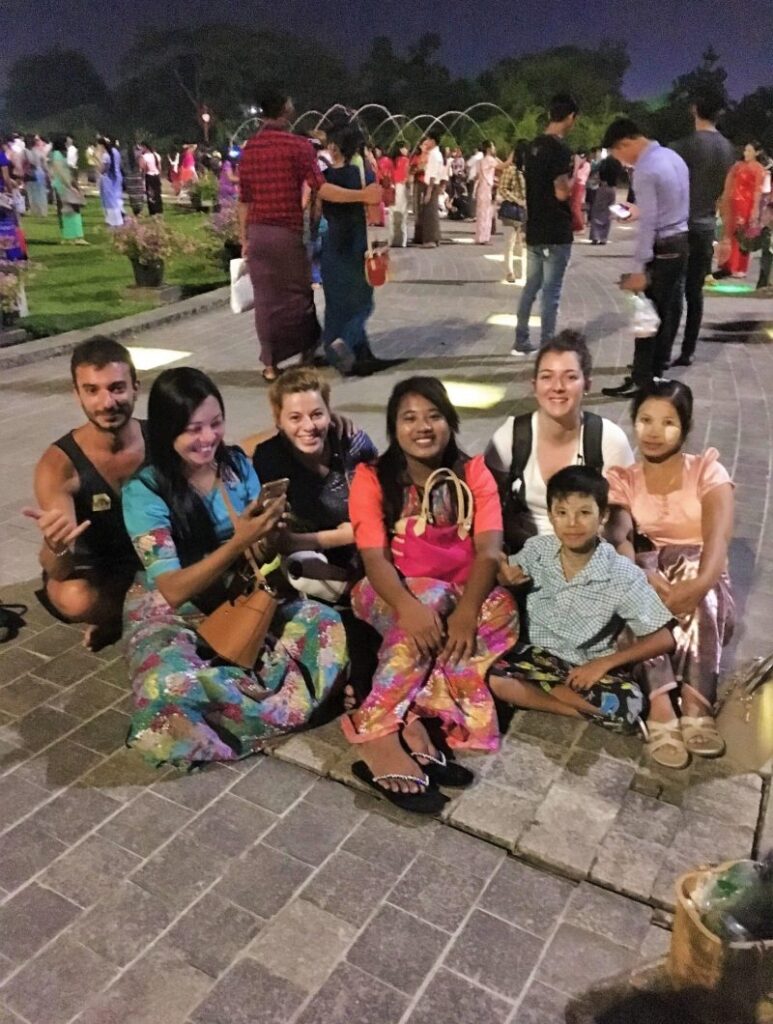
Full Moon celebration at Maha Bandula Park
The light show came to an end and we decided to walk to Maha Bandula Park to see if there was something going on. The park was kind of far away from where we were and, after a while walking, we decided to take a taxi. As we approached the park I stopped at a food stall and got two meals for 2 K. So cheap and good!
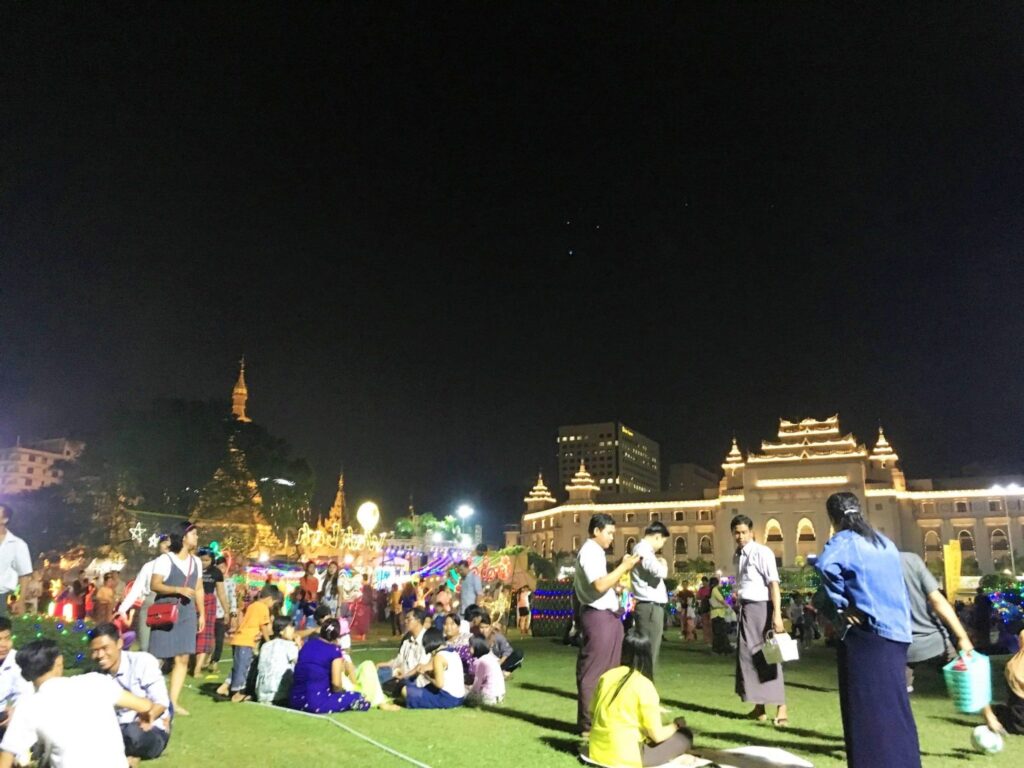
We then bought some beers and sat down on the grass, to enjoy the lights and the music. Again, plenty of locals but no sign of tourists. After a while, we even played card games lol. I guess that triggered it all and, at around 22:30, we said good bye and I went to my hostel to sleep. On the way there I crossed a street which was full of boys playing football. Some areas of Yangon where like little towns of Andalusia! And, just like that, the first of my 2 days in Yangon was over 🙂
Day 2 in Yangon
I woke up at 08:30 with a feeling of having properly rested. I didn’t remember the last time I woke up at such a time lol. The breakfast, included in the price of the room, was super good. I decided to extend my stay at Backpacker Hostel for one more night and I changed rooms. As mentioned earlier, I had booked one night in a shared room but, because it was full, they upgraded me to a 3-person bedroom (which was amazing, by the way). The shared room had plenty of beds but it was clean, spacious and the mattress was super comfortable. Backpacker Hostel was one of the best hostels I stayed at during my time in Southeast Asia, so, check it out!
With my new bed ready and my stomach full, I spent a couple of hours deciding where to go after Yangon. It took me a while but eventually I decided to skip the Golden Rock and Mawlamyine and go to Bago and Hpa-An. One of the guys working at the hostel told me that, in order to go to Bago, I would need to go to the Yangon Train Station and buy my train ticket there. So, it wasn’t like bus tickets, which you could buy at some hostels.
Yangon Circular Train
I had already visited some of the highlights of Yangon: Maha Bandula Park, Sule Pagoda, Shwedagon Pagoda and People’s Square and Park. Nonetheless, there were still a few cool things to do. One of them was taking a circular train around Yangon. That allows you to get a feeling on people’s daily lives in Yangon as well as to take a look at the landscape around the city.
About Yangon Circular Train
The Yangon Circular double track railway was built in 1954 by the British. Operated by Myanmar Railways, the 39-station loop (46 km) system connects towns and suburbs within the Yangon metropolitan area. The train takes around 3 hours to finish the loop and it is a nice way to see a cross section of life in Yangon. The train ticket costs 200 MMK (around 0.10 Euros). Yes, you read well. 10 cents for a 3-hour loop train. With that price I guess you wouldn’t be surprised if I told you that the train was full of locals, moving from one place to another while selling food.
I did some research on the Internet but it took me a while to understand how the Yangon Circular Train worked. Since it is a double track railway, the trains goes in two different directions, one clockwise and another one counter clockwise. I did some research online but couldn’t find many train plans or timetables, until I found one at Travelfish, a travel blog I love 🙂
The Yangon Circular Train experience
Thus, eventually, I decided I would start my Yangon Train Circular journey at Yangon Central Railway Station. There was one train leaving clockwise at 13:05 and that was the one I wanted to catch. There were a couple of km from my hostel to the station so I just walked there. I arrived right on time. I walked downstairs and ran into a plan and a timetable which, except for the name of the stations, I didn’t understand much. It looked like this:

I asked the locals around where I had to buy my ticket and which one was the right platform. After paying 0.10 Euros, I was ready to get onto the Yangon Circular Train. As I was walking towards one of the coaches… I saw Lea and Clara! We were supposed to meet at 17:00 at Maha Bandula Park but we had just run into each other. It was the second time that happened and it wouldn’t be the last one… At 13:05 the train was ready to leave. It was super punctual although, as far as I know, that is not always the case 🙂
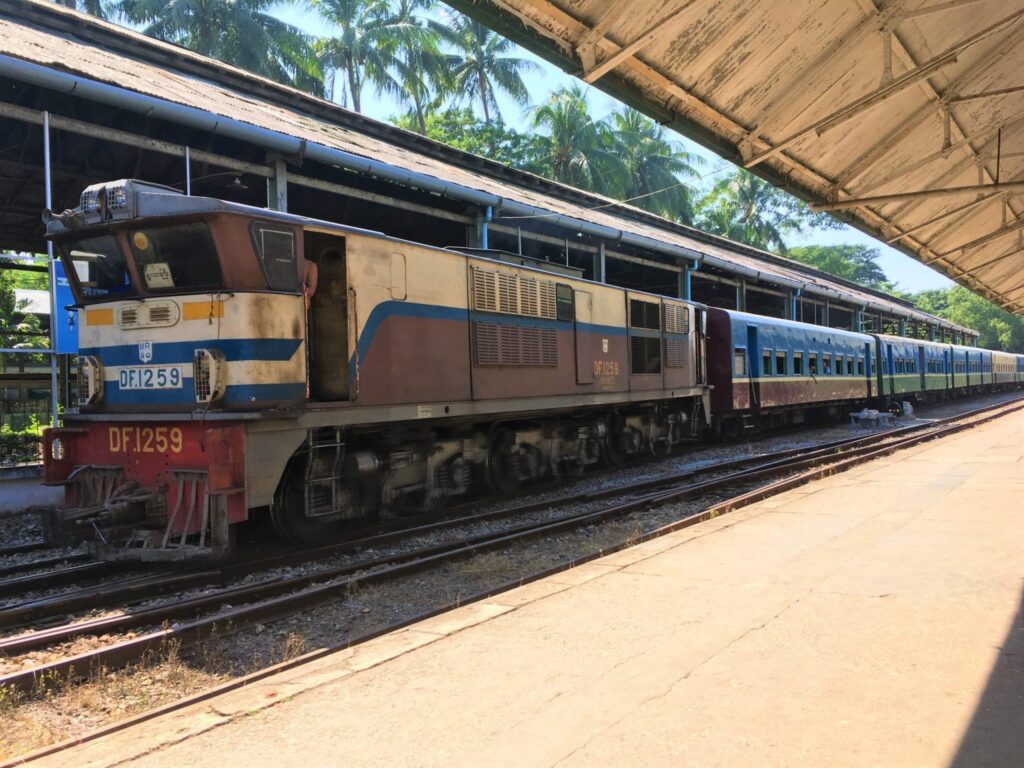
There were not many seats in the train and most of them were occupied. That was a constant throughout the whole journey. So, we spent most of the time standing up or sitting on the floor. A little after the train started running, a local man who looked funny and kind started to speak with us.
Apparently, Lea and Clara had already met him. He was curious about where we were from, what we were doing there and other stuff. As I’ve been mentioning throughout the post, I didn’t run into many tourists during my 2 days in Yangon. Thus, I guess locals are not used to meet us. He told us about his life, the situation of Yangon and Myanmar and even wrote down some Burmese words for us 🙂
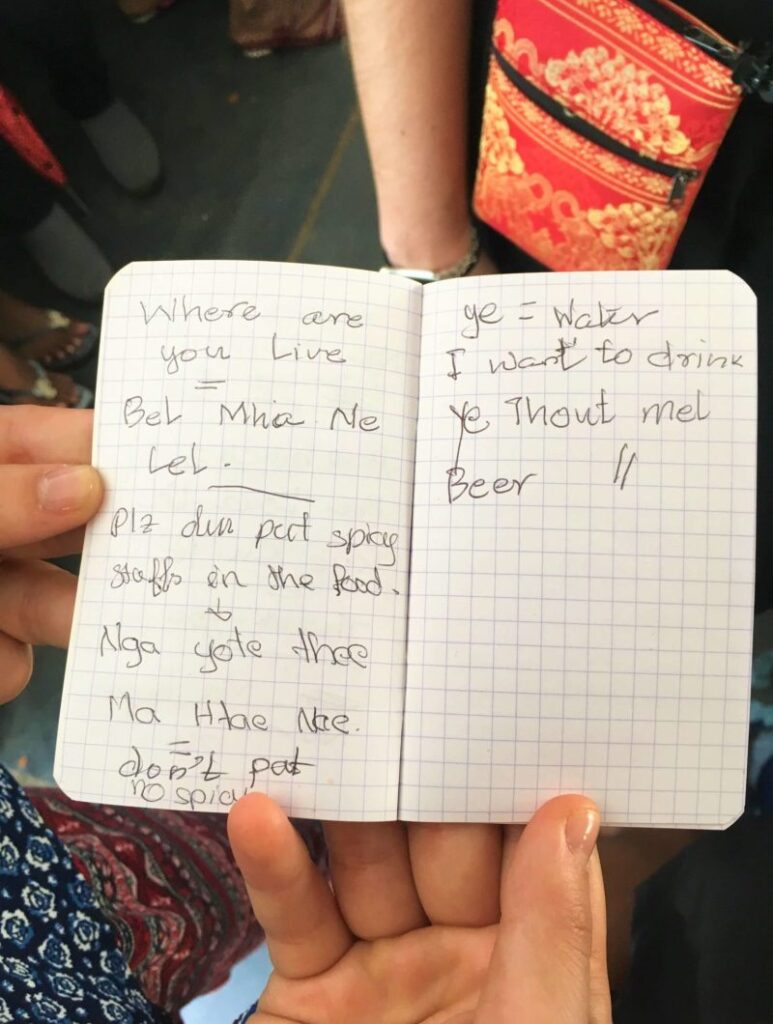
He seemed very kind but, when his time came to leave the train, he asked Clara and Lea for money. Unfortunately, they were not being very lucky with that. Apparently, they had been involved in similar situations with other locals before. Luckily enough that hadn’t happened to me yet so I kept my fingers crossed.
The train, other than taking passengers to their destination, was also used as a food market. Locals were selling any kind of food: vegetables, deep-fried stuff, snacks, fruit and candies. It was impressive seeing women carrying heavy baskets full of different stuff on their heads!
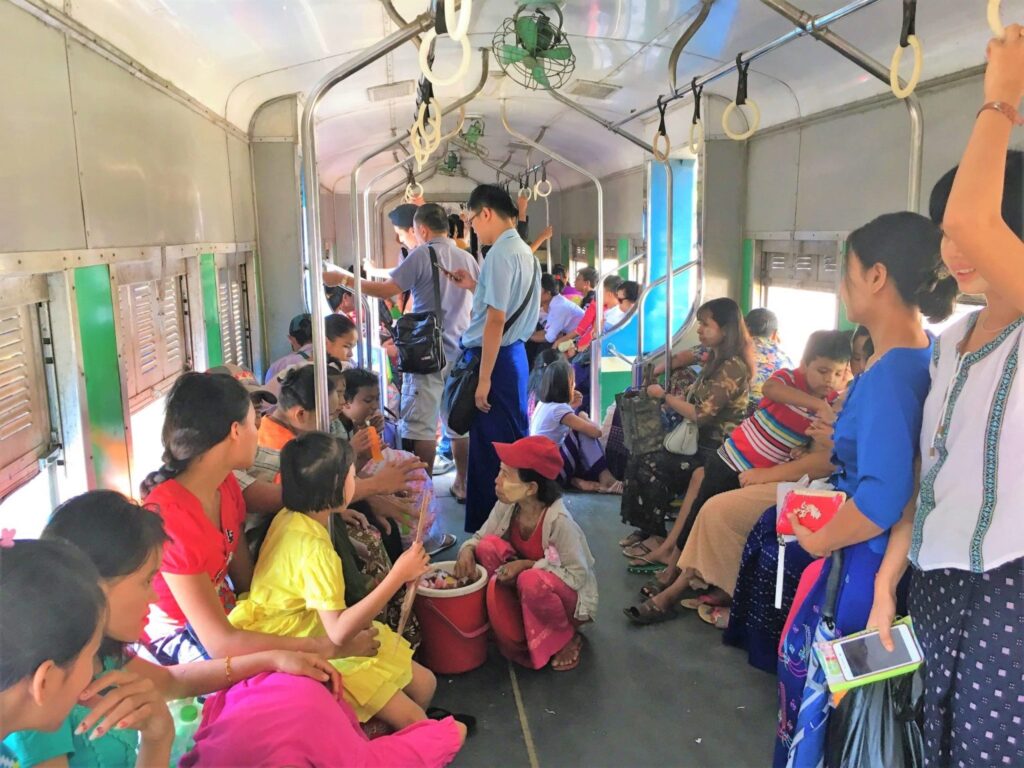
The train didn’t have aircon. Apparently they tried to implement it but it just lasted a couple of years due to a slightly increase on the train ticket fee 😅. It had though funny fans hanging from the roof. They were not very effective but they gave a cool touch to the train. Most of the people in the train were locals and I exchanged some words with some kids. They also asked me to take a picture with them. Again, they are not very used to seeing tourists.
At one point, I was standing in front of some kids. They were talking and eating some stuff and, when they finished them, they threw them through the window. The “funny” thing is that they had a trash bin right next to them. I couldn’t let it pass and I asked them why they did that. They were surprised both to see me “scolding” them but also to tell them throwing rubbish through the window was not something they should do. The same happened with the locals around. Unfortunately, they have still a very long way to go, mostly on education about rubbish, recycling and the impact it all has on the environment.
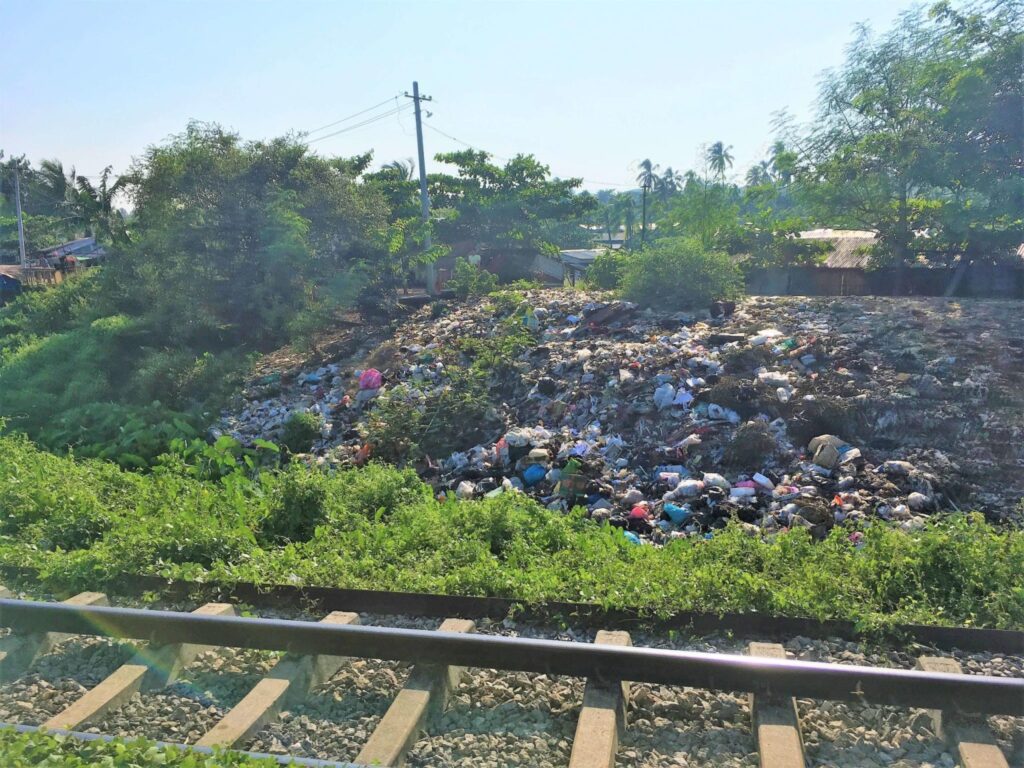
That though is not just their problem, but everybody’s. We, as a species, should start applying common sense on the rubbish and environment topic. Similar situations happened in my country before and, unfortunately, still happen nowadays. While not at the same level, there are still plenty of people who throw the rubbish on the ground or who don’t recycle. And not just that, but many countries from Europe and the rest of the world (including Spain) send thousand of tons of rubbish to other poor countries in Asia like Malaysia, the Philippines or Vietnam. This behaviour leads to the picture shown above but, if we all do our best, it could lead to this one instead:
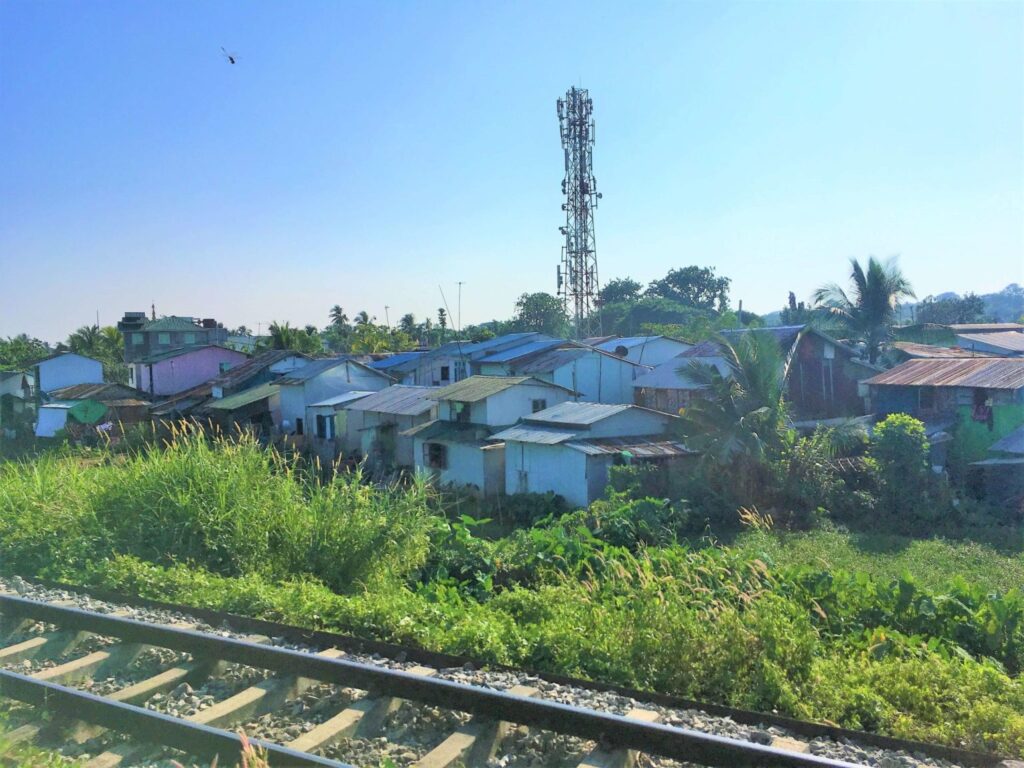
Throughout the 3 hours we spent in the train the landscape changed quite a bit. It wasn’t super impressive but I was glad I decided to go on the Yangon Circular Train. All the passengers seemed nice and when we interacted with them, they were always kind to us. The “food market” wasn’t just taking place inside the train but also outside. We saw people trading at every station the train stopped but also next to the rails, as the train was passing by. Just to give you the heads up, it seems the train will change its current form by 2020, so, if you want to experience it as its best, go to Yangon now! 🙂
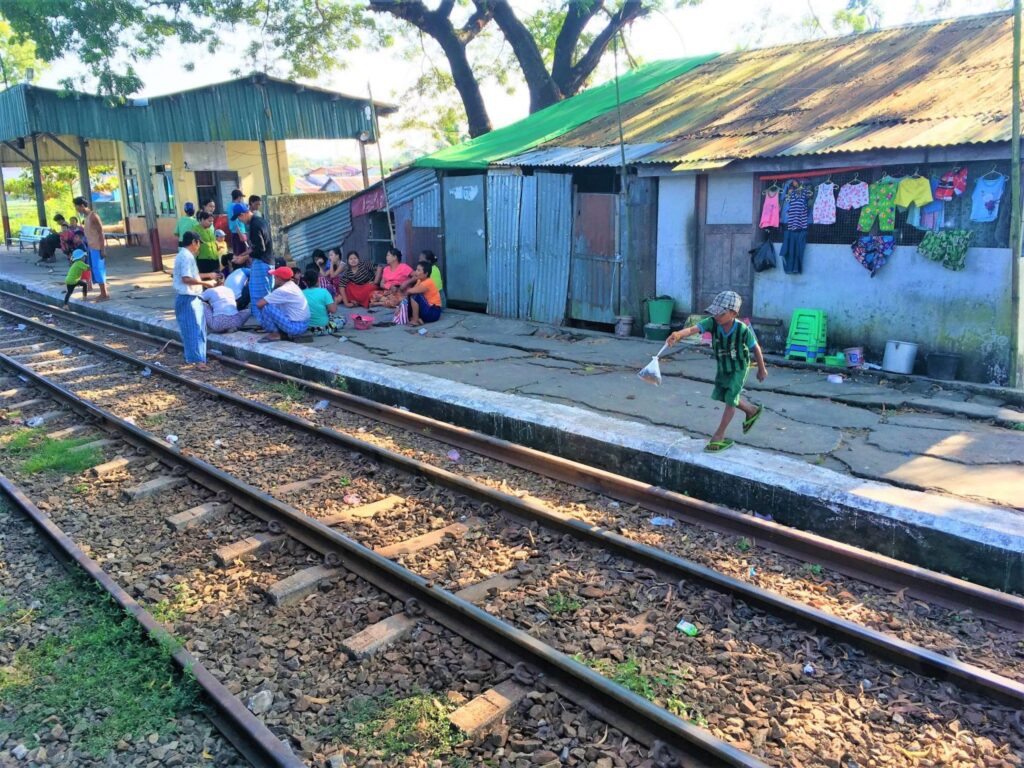
Looking for food in Yangon
I know it sounds like an irony but, after the 3 hours in the Yangon Circular Train, we were super hungry. Thus, once we were back at the starting point (Yangon Central Railway Station), we started to stroll around, trying to find a place to eat. It was around 17:00 so it wasn’t the best time to go have lunch. Many bars and restaurants were closed and some of the typical food stalls were taking a break to re-open at night. And we were so hungry! I remember it as if it was yesterday.
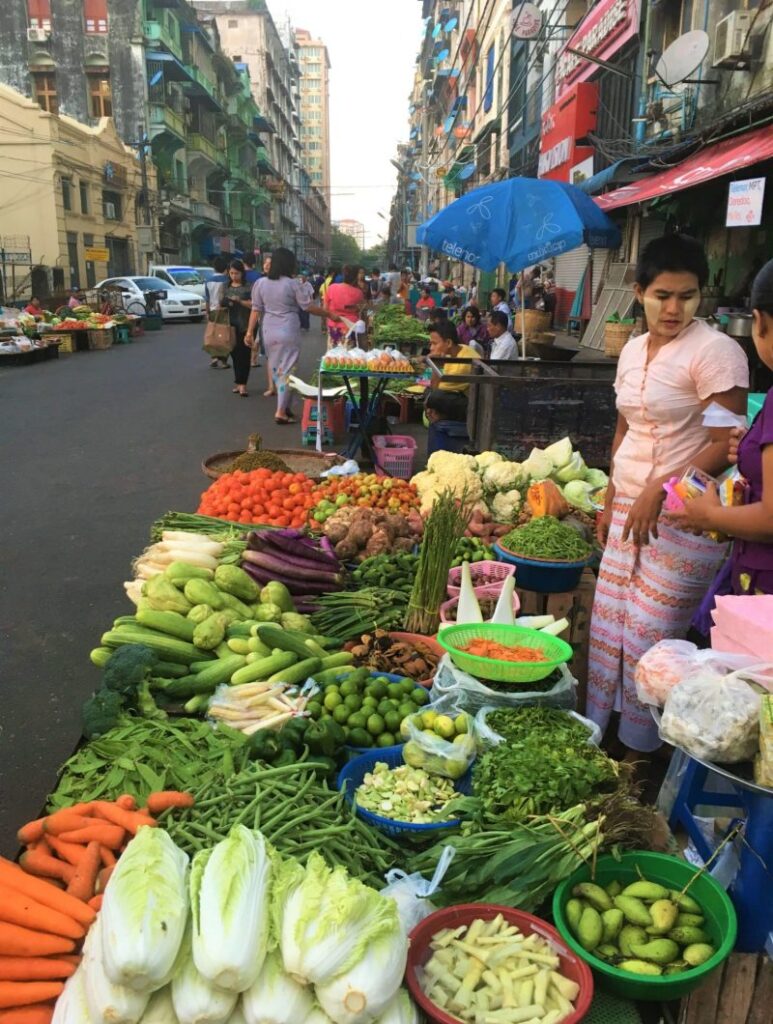
At some point, we saw a huge queue of people. We were not sure what was happening and we tried to ask a few locals but we couldn’t understand anything lol. There were vegetables stalls at some streets but we were looking for a proper hot meal. Thus, when we eventually found an Indian restaurant, we were about to cry. And the feeling increased when, after a lot of discussion, signs and other techniques, we were able to order white plain rice with vegetables and tons of delicious naan. It was so good! They were cooking it on the spot in a stone oven. The naan master was using a bottle of beer to knead it. Not sure if it was because of that or because we were starving, but it was delicious!

Yangon China Town
After the tasty lunch we decided to go check Yangon China Town, aka Tayoke Tan. As it happens in other cities around the world, the neighbourhood of China Town is famous for food, drinks and a fun night life. It was just around 18:00 but we decided to give it a try anyway. China Town has different streets but the most popular one is the 19th Street. So, that’s where we headed to. On the way there we had the chance to appreciate some of the buildings of Yangon, which I really liked 🙂
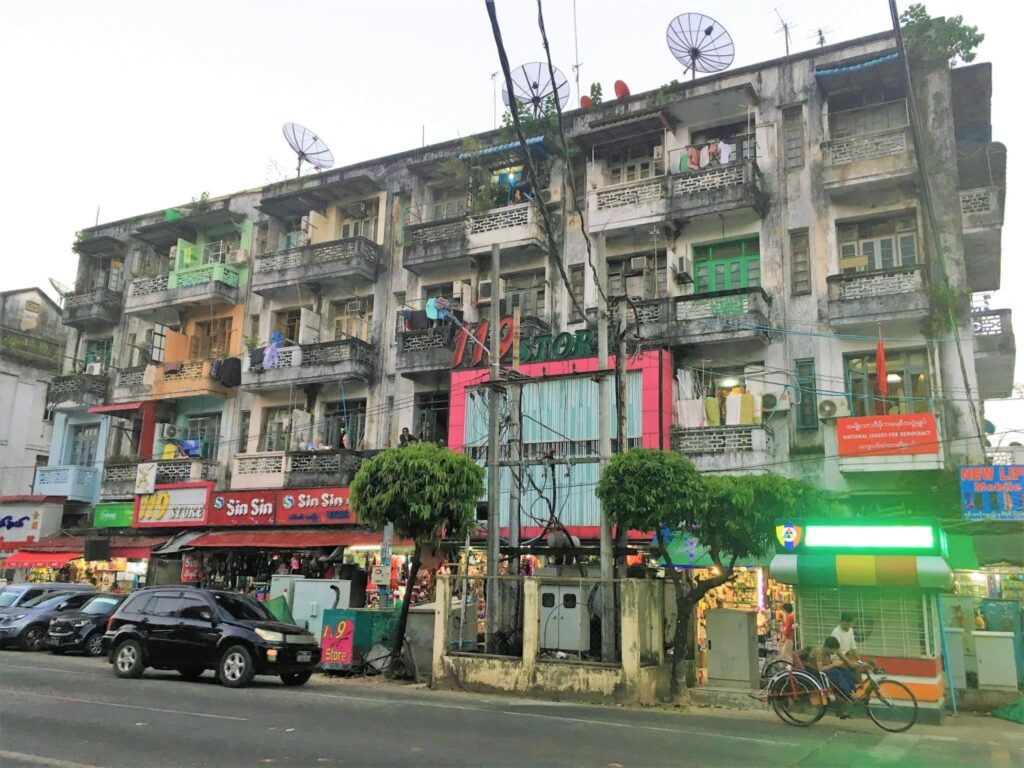
We could feel a different vibe as we were approaching Yangon China Town. There seemed to be more lights, noises and activity than in other areas of the city. It was then that I (finally?) started to see some tourists. There were also (unfortunately) kids begging for money. I’m always against giving then money but I don’t mind buying them some food. All in all, it’s really sad to think that it is their own parents the ones sending them to beg.
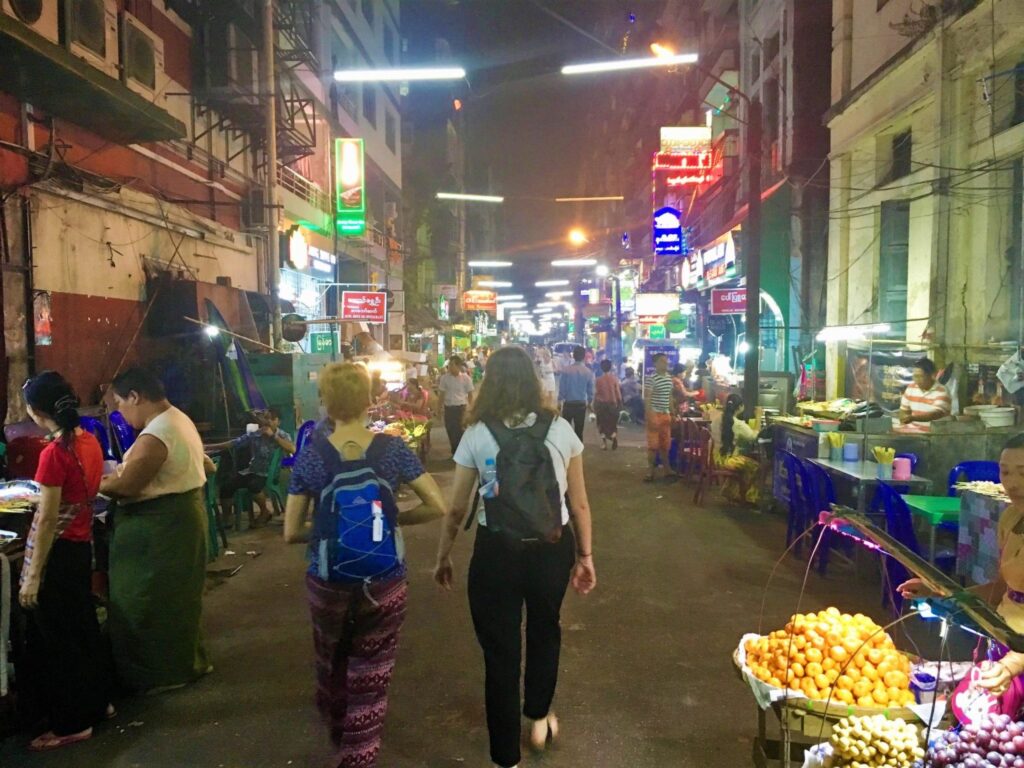
It wasn’t super busy at that time but you could feel the street was a crowded one. After walking for a bit, we sat down at a regular restaurant and started to order some beers. They had local ones as the “Myanmar” but also foreigner ones as the “Tuborg”. I would have never imagined it lol. All through the street, other than bars and restaurants, there were plenty of food stalls. It wasn’t like Khao San Road but the 19th Street of Yangon China Town had its magic.
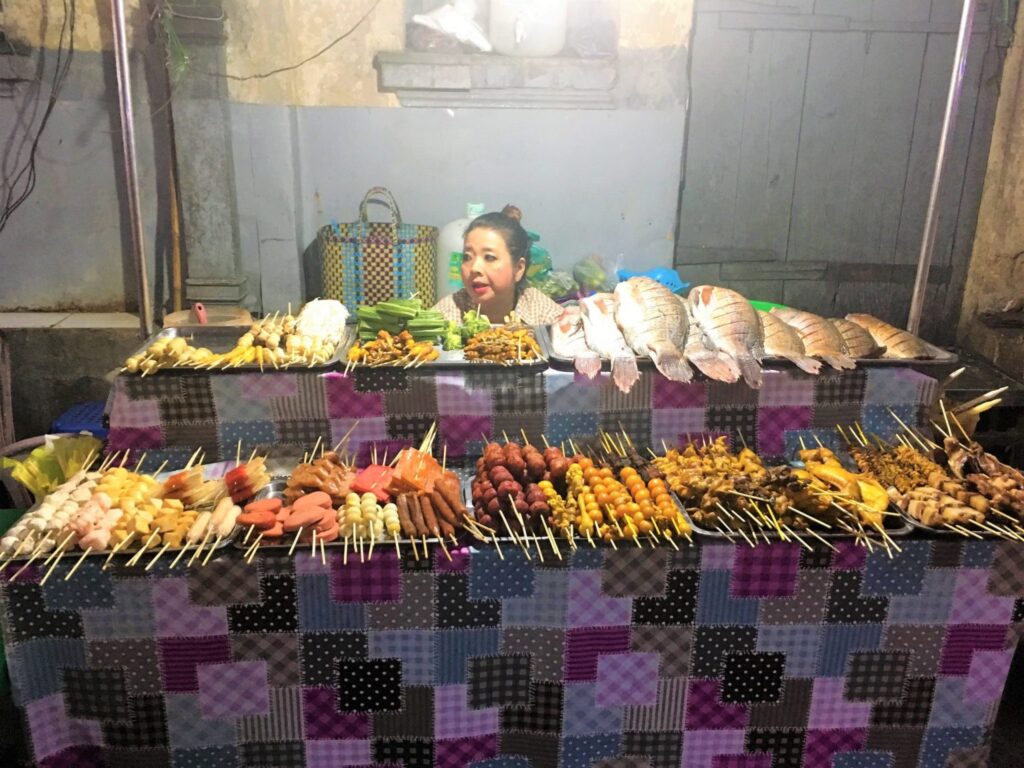
Paan chewing tobacco and the reason behind the orange stains
We had a good time in Yangon China Town but, as soon as we left the restaurant and started walking, we felt pretty tired. Nonetheless we decided to go take a look at Maha Bandula Park for one last time and enjoy the Full Moon celebration. On the way there I stopped at a curious stall. I wasn’t sure about what they were selling. I tried to ask them but they couldn’t understand me. The same happened with the people around. Eventually, they offered me to try it. And… that’s how I got to learn about the Paan, or chewing tobacco.
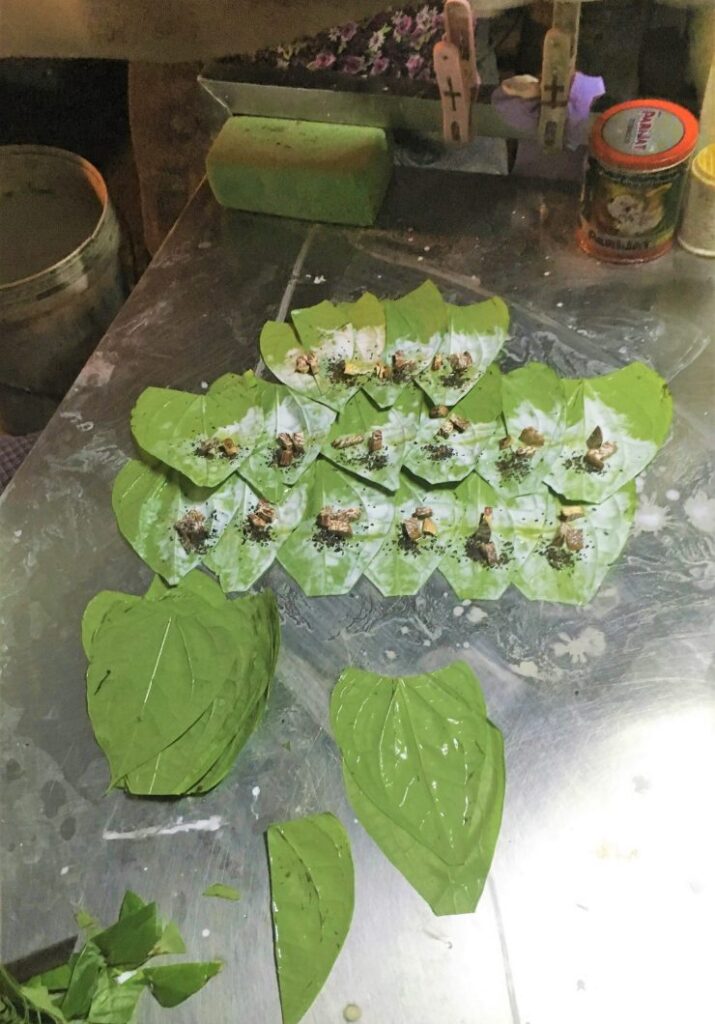
Paan is a preparation combining betel leaf with areca nut. It is widely consumed in Southeast Asia, East Asia and the Indian subcontinent. It is chewed for its stimulant and psychoactive effects and, after a while, spat out or swallowed. Its flavour and composition varies depending on the region. In Myanmar, the most common configuration is a betel vine leaf with areca nut, slaked lime and some aroma. Some consumers also add tobacco.
When chewed, it releases some sort of an orange color, which you can appreciate on consumers’ teeth, walls and on the ground. Myanamar is full of orange stains due to that. Since the 1990s, its consumption has been actively discouraged but, people keep doing it. In 2007, betel chewing and smoking tobacco have been banned from the Shwedagon Pagoda. And in 2010, the government prohibited people selling it within 50 meters of any school. My experience wasn’t very “sweet”. It tasted kind of strong and bitter and, after a few seconds, I had to spit it out lol.
So long Yangon!
Eventually we made it to Maha Bandula Park. Before that though I was able to try the “Burmese churros” and they were pretty good! There were plenty of locals eating, sitting down and just enjoying the night. There were some bands playing as well as light shows. We sat down there and enjoyed the celebration for a while. We played cards again and they beat me easily lol. After a while, we said goodbye and our paths separated… But Yangon wouldn’t be the last city where I would meet Clara and Lea again. Sometimes fate is fickle 🙂
So, how did you like my 2 days in Yangon? Have you ever been there? Have you tried the Paan or betel chewing? Did you hire a guide for the Shwedagon Pagoda? Was it worth it? How do you like the food in Yangon? Does anybody know the name of the “Yangon Cathedral”? Let me know in the comments below!
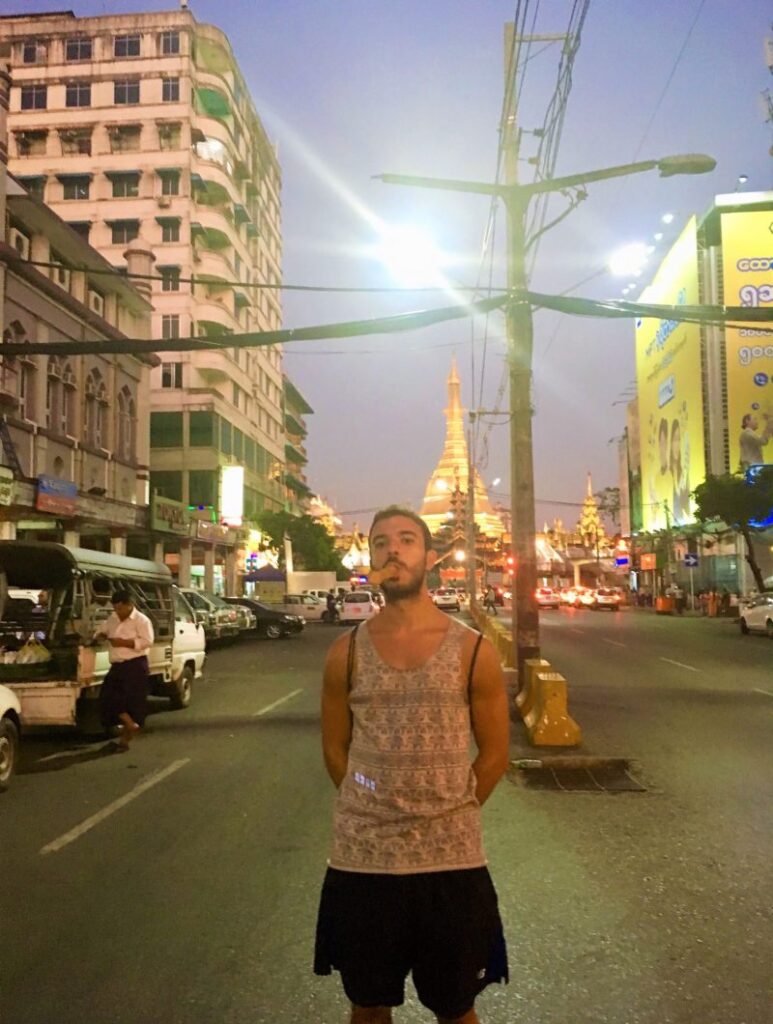


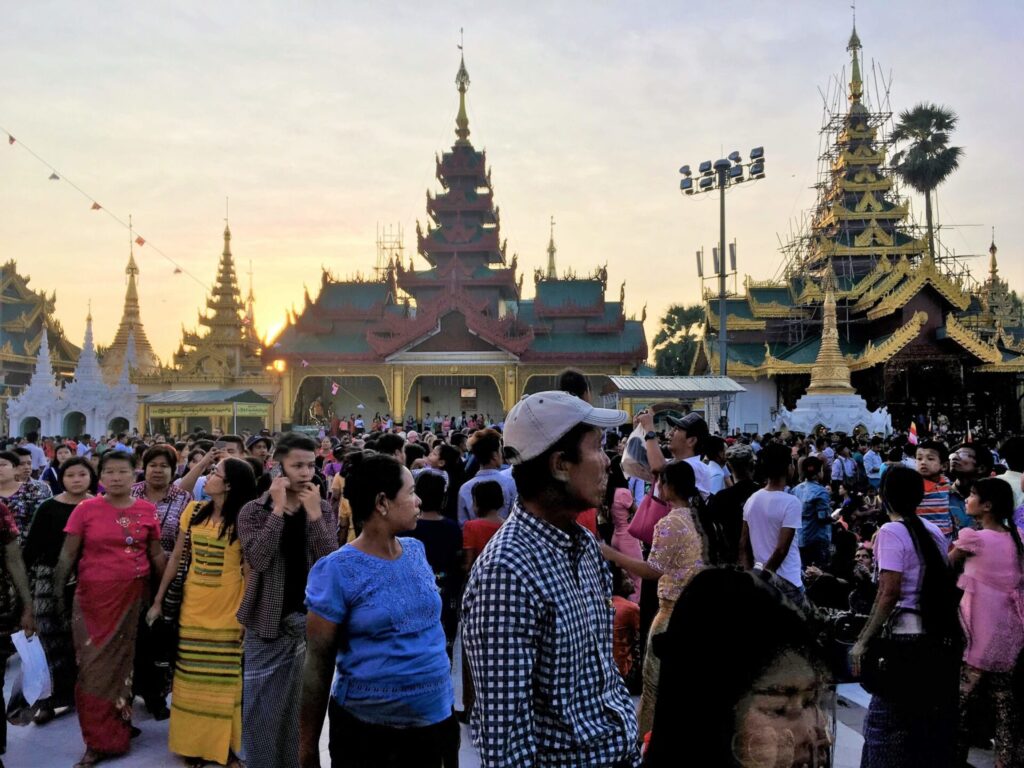
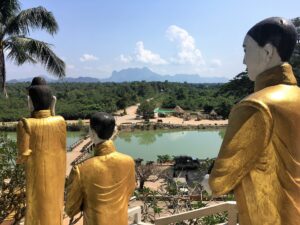




2 Responses
Awesome post! Keep up the great work! 🙂
Thanks a lot! 🙂